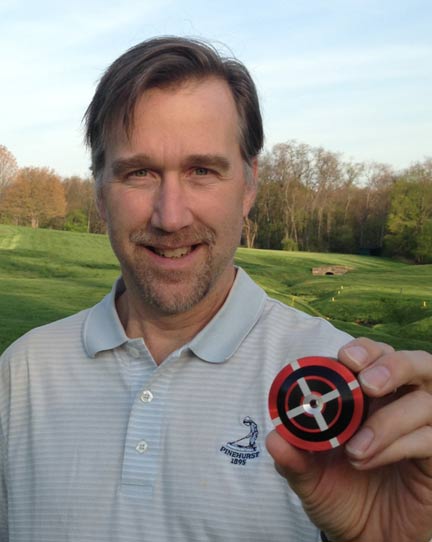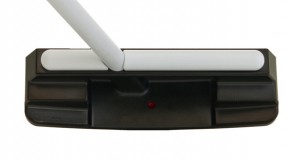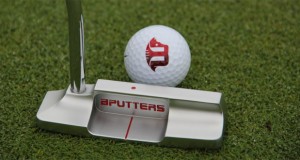At PutterZone.com, we love training aids that are simple to use, and easy to store and transport. So when we learned about the new Dead Zero Putting Disk, it’s inherent simplicity caught our eye. Milled from anodized aluminum, the Dead Zero Putting Disk takes the idea of a reduced-sized training cup to a new portable level. We recently caught up with inventor Eric Schmitt to learn more about the disk, which will be available starting on June 1 for a retail price of $24.95. Schmitt is an avid golfer and marketing professional based in Pittsburgh, and it has been a six-year journey for him to bring the Dead Zero Putting Disk from the original idea to a finished product. Here’s our conversation:
Tell us about the Dead Zero Putting Disk (DZPD)—what is it, and what does it do?
The DZPD helps golfers build confidence to make more putts that matter the most when playing – those of 8′ and less. It is a disk that is sized (diameter) such that any putt that hits it represents a putt that would have gone into the hole. The concept is based on training with reduced-size targets and is no different in concept to reduced-rim basketball hoops, skinny baseball bats and reduced club faces on irons or the reduced diameter cups you might find on practice putting greens. For anyone who has practiced putting with a reduced diameter cup, you are familiar with the benefits. You take aim at a target smaller than normal, and when you switch to a regulation cup, the hole looks gigantic. You have built confidence when facing those make or break putts. The only downside to the small cup on the putting green is that it is stationary. You can’t practice wherever you want or whenever you want. You can use the DZPD on any green, in any location or anywhere you want to practice.
 How is it different than any other small above-ground object that the golfer might place on the green?
How is it different than any other small above-ground object that the golfer might place on the green?
The DZPD has been sized appropriately so that any putt that (direct or even a slight glance) hits the disk at a normal/ideal pace represents a ball that would have gone into the hole. I applied research from putting and short game guru Dave Pelz, who stated that an ideal speed of a putt is one that would have traveled 17″ past the hole had it missed. I began rolling putts with a stimpmeter aimed at the center of the cup with a speed that would travel 17″ past the cup. I then began aiming the ball in small increments to one side of the cup until the ball lipped out versus falling in. I marked the point in front of the cup where the ball passed and measured the distance from that point to the center of the cup. I repeated the process to the other side of the cup and at several other cups to ensure I had a statistically significant number. By doubling the distance from center average, I now had the key diameter with which to create an above-ground target that represented a golf hole if struck with a putt. That unique diameter size is what separates the DZPD from any other above-ground target and that is the basis for my patent application which was filed last year.
What inspired you to create the Dead Zero Putting Disk, and how did you develop the name?
I’ve played golf for many years and have had the good fortune to work in the golf industry at different times as well. One stat that I remember seeing was that handicaps over the past 20 years have essentially remained flat, dropping only by one, despite the fact that we have all this great new technology today. Clubs hit the ball longer, higher and straighter. Balls fly farther and provide greater forgiveness around the greens. So why aren’t we all that much better? I believe that the answer lies on and around the greens. The adage that you drive for show and putt for dough is accurate. The same holds true for the pros. There are more tour players at the top of the PGA money list that are ranked highest as putters versus those that rank highest as long drivers. After putting to small cups on putting greens myself, I experienced the increased confidence you get when you begin to putt to regulation sized cups. I felt the difference, but also realized that I was limited in having access to those smaller cups and wanted to create a version of the reduced diameter cups that I could use anywhere.
My first name choice was Dead Aim Disks, but “Dead Aim” is already trademarked. I went through several other name options before finally settling on Dead Zero, which is a term used by hunters or marksmen when their target is directly in the crosshairs.
Can you describe your entrepreneurial journey, from concept to retail product? How did it go? Was it harder or easier than you thought?
The journey has been a long one. I first conceived the idea almost six years ago. It sat in my “idea file” for almost three years before I decided to act on it or regret it forever. I’ve had a lot of help along the way and have gathered a lot of good connections in my life and career to help it become a reality. There are so many details that go into getting an idea like this off the ground and doing this part-time prolongs the process. It feels really good to have made it this far and to see what started as an idea sketched on a piece of paper take shape and ultimately become a product that other golfers or friends of golfers might want to buy. It was by no means an easy journey, but it wasn’t terribly difficult assuming you have patience and perseverance. As I stated earlier, I was fortunate to have some handy connections to help me in product development, testing, design, legal and my website (DeadZeroPutting.com).
Thanks, Eric! Stay tuned for PutterZone’s Dead Zero Putting Disk review.
 PutterZone – Best Putter Reviews
PutterZone – Best Putter Reviews




